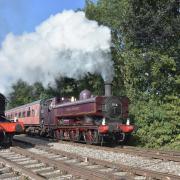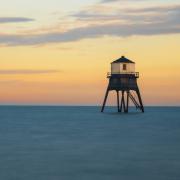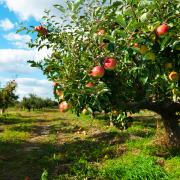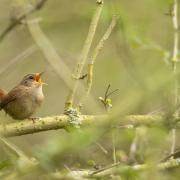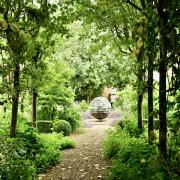Simon Taylor on behalf of the Public Rights of Way team at Essex County Council takes an accessible walk stretching six-and-a-half miles through beautiful Essex countryside
THE ROUTE
Note: this is an accessible walk with no stiles.
1. From the layby turn right along the lane towards Littlebury Green. Turn left, opposite a post-box, and pass The Hoops on the left and The Old Rose on the right before emerging into a beautiful track where the leaning hedges meet overhead (near the coast this would have been a ‘tunnel’ used by smugglers of old). After a straight field-edge section the route kinks right then left, then follows the field edge, with the hedgerow on your right, for 700 metres. Keep straight on at the corner of Free Wood, passing an interesting oak tree with a hollow base and two main trunks. The wood-side path then leads to Freewood Farm.
2. In the farmyard turn right, as indicated by a waymark post, passing between farm buildings and some old pens on the left. The concrete track, leading to tarmac, now follows the western edge of Free Wood. At the corner, turn right onto a byway as indicated by a concrete fingerpost. This is part of the Icknield Way, a long-distance path which runs between the Chilterns and Thetford Forest, said to follow the route of one of the oldest roads in Britain. Those looking closely at OS maps will notice something of an Essex rarity in this area: contour lines with 3-digit numbers! This is some of the highest ground in Essex, demonstrated by the expansive views north into Cambridgeshire. In just over a kilometre, a waymark post indicates a bridleway on the left. Turn here, downhill, and sweep right to emerge at an arable field. Turn left at the waymarker to visit St. Mary The Virgin Church, Strethall.

3. Retrace your steps from the church and turn left at the waymarker in the dip, from where the path leads to a pair of fingerposts. Turn right and follow the path all the way to a lane. Turn left onto the lane and amble through the quiet village. Just past the old water pump on the left, a byway on the right is indicated by a rather overgrown concrete fingerpost. Turn here, the route becoming an old sunken lane, hedged on either side. On emerging at the bottom of the hill turn right and then left, back up the other side of the valley, crossing the farm track to emerge onto the lane which passes through Littlebury Green. Turn right and in 200 metres on the left is the green corrugated iron structure of St. Peter’s Church, Littlebury Green.

4. From here, weary walkers can return along the lane back to the starting point. To continue the route, though, after 150 metres turn left along a wide green indicated by a concrete fingerpost. The path leads along the side of a field to pass adjacent to Green Wood, containing some magnificent oaks. Skirt the deer-fenced wood for 400 metres then at a sign for the ‘Audley End Estate’ follow a wooded path leading past Chapel Green Cottage and on to a quiet road.
5. Turn right and follow the road for 900 metres, admiring the view east across rolling chalkland topography, the M11 motorway and Stansted air traffic providing a contrast to the otherwise rural tranquillity. Turn right again along the field-edge track by a radio mast, pass beside a metal gate and continue with the hedge on your right. In 250 metres turn right at a waymarker and then keep to the field-edge track for well over a kilometre. On reaching two large oaks near a bench, keep straight, ignoring turns to the right and left, to soon emerge back at the start-point layby.
COMPASS POINTS
Distance: 6.5 miles (10.5km)
Starting point: A layby at the entrance to a bridleway, on the side of the lane, just southwest of Littlebury Green, postcode CB11 4XB, grid reference TL484381
Access: Park in the layby. There are no scheduled buses in this remote corner of Essex, but Demand Responsive Transport (DaRT) is available (bookings@essexandsuffolkdart.co.uk) to link with scheduled services in Saffron Walden
Map: OS Explorer 195 Braintree & Saffron Walden
Refreshment: There are no pubs or shops (or public toilets) on this rural route! The nearest pubs are The Queens Head at Littlebury (2 miles to the east) or The Red Cow at Chrishall (3 miles to the west). There are a full range of facilities in Saffron Walden, 4 miles to the east.
Places of interest: The two CoE churches visited on the route could hardly be more different. Sited on the ancient Icknield Way, St. Mary The Virgin at Strethall has an Anglo-Saxon nave and chancel arch providing direct evidence of more than a millennium of worship in the same building. Even the church bells are ancient, dating from before 1360. By contrast, St. Peter’s at Littlebury Green was built in 1885, to serve as a ‘chapel of ease’ and save the hamlet’s residents the 4-mile round-trip to Littlebury church. It was made from a kit, several of which survive nationally and are known collectively as the ‘tin tabernacles’. St. Peter’s is a particularly fine example, surviving almost unaltered with the corrugated iron exterior and pine boarded interior, with horse hair in-between, alongside most of the original fixtures such as the pews, windows, altar and altar rail. As well as regular services it serves as a community hub. Situated immediately next to St. Peter’s, ‘The Bumpy’ is a small local nature reserve which is well worth a visit.
Further afield, just 3 miles to the east lies Audley End house and gardens. Built in the early 1600s on the site of a Benedictine monastery, it was once three times its current size and one of the finest houses in England, surrounded by gardens landscaped by Capability Brown in his very characteristic style. At one time owned by King Charles II, it is now the property of English Heritage and is open for the public to visit.
The nearby town of Saffron Walden offers plenty of interest: as well as shops, pubs and restaurants it boasts Essex’s largest parish church, a museum, a ruined castle and some lovely public gardens, all with a quaint, rural market town atmosphere.


















